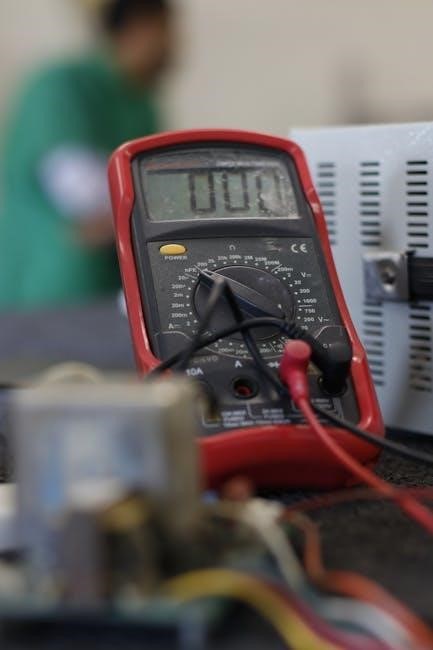The Electrical Aptitude Test assesses candidates’ skills for electrician roles, focusing on math, reading, and technical knowledge. It is administered by organizations like IBEW and NJATC.
Free PDF resources are available for practice, helping candidates prepare effectively for the exam and improve their chances of success in apprenticeship programs.
1.1 What is the Electrical Aptitude Test?
The Electrical Aptitude Test is a standardized assessment designed to evaluate candidates’ skills and knowledge for careers in the electrical industry.
It focuses on key areas such as mathematics, reading comprehension, and technical reasoning. The test is typically used for apprenticeships and electrician roles.
Administered by organizations like the IBEW and NJATC, it consists of 69 questions divided into two main sections: 33 math-related questions and 36 reading-focused ones.
Candidates must complete the test within a tight time frame, with less than 90 seconds per question on average.
Free PDF resources and online tools are widely available to help candidates prepare effectively for this exam.
1.2 Importance of the Electrical Aptitude Test
The Electrical Aptitude Test plays a crucial role in evaluating candidates’ skills in mathematics, reading, and technical knowledge. It ensures that individuals possess the necessary abilities to perform safely and effectively in electrical roles.
The test is essential for apprenticeships and employment in the electrical industry, as it identifies those capable of handling complex tasks.
By assessing aptitude, the test helps reduce workplace errors and enhances safety standards.
It is a key step in the selection process, ensuring only qualified candidates advance in their electrical careers.
The test’s results are widely recognized by industry organizations and employers.
1.3 Who Administers the Test?
The Electrical Aptitude Test is primarily administered by the International Brotherhood of Electrical Workers (IBEW) and the National Electrical Contractors Association (NECA). These organizations, through the National Joint Apprenticeship and Training Committee (NJATC), ensure the test meets industry standards. The test is also used by local apprenticeship programs and training centers. The IBEW/NJATC partnership focuses on providing standardized assessments to evaluate candidates’ readiness for electrical careers. This collaboration ensures the test remains relevant and effective in identifying qualified individuals for the trade.

Structure of the Electrical Aptitude Test
The test includes sections on mathematics, reading comprehension, and technical knowledge. It evaluates problem-solving skills, understanding of electrical concepts, and the ability to interpret industry-related materials effectively.
2.1 Overview of Test Sections
The Electrical Aptitude Test is divided into three main sections: Mathematics, Reading Comprehension, and Technical Knowledge. The Mathematics section includes algebra, functions, and numerical series, while Reading Comprehension focuses on understanding technical passages. The Technical Knowledge section assesses familiarity with electrical concepts, such as circuits and safety protocols. Each section is designed to evaluate different skills essential for a career in the electrical field. By understanding the structure, candidates can tailor their preparation to address each area effectively, ensuring they are well-equipped for the exam. Proper time management and focused study are crucial for success. Additionally, utilizing practice resources like PDF guides and online simulators can help candidates familiarize themselves with the test format and content, reducing anxiety and improving performance. Regular review of study materials and consistent practice are recommended to achieve a high score, which is often a requirement for apprenticeships and licensing.
2.2 Mathematics Section Breakdown
The Mathematics section of the Electrical Aptitude Test focuses on algebra, functions, and numerical series. It includes 33 questions that must be completed within a limited time, requiring strong problem-solving skills. Topics such as solving equations, understanding functions, and identifying patterns in number sequences are emphasized. This section evaluates the candidate’s ability to apply mathematical concepts to real-world electrical scenarios, such as calculating circuit loads or determining conductor sizes. Accurate and efficient problem-solving is crucial, as it directly impacts the candidate’s overall test score and eligibility for apprenticeships. Regular practice with sample questions is highly recommended to build confidence and speed.
2.3 Reading Comprehension Section Breakdown
The Reading Comprehension section evaluates a candidate’s ability to interpret and understand technical texts. It contains 36 questions, often focusing on passages related to electrical theory, safety protocols, and industry standards. Topics may include the National Electrical Code, circuit analysis, and equipment operation. Questions are designed to test comprehension, requiring candidates to identify key details, understand complex sentences, and draw logical conclusions. This section assesses the ability to process information quickly and accurately, a critical skill for success in electrical apprenticeships and real-world applications. Strong reading skills are essential for interpreting blueprints, manuals, and safety guidelines in the field.
2.4 Technical Knowledge and Reasoning
The Technical Knowledge and Reasoning section evaluates a candidate’s understanding of electrical concepts and problem-solving skills. Questions cover topics like electrical circuits, wiring methods, and safety protocols, often requiring the application of theoretical knowledge to practical scenarios. This section assesses the ability to analyze diagrams, interpret electrical codes, and apply logical reasoning to resolve technical issues. It also includes mechanical reasoning questions, testing understanding of tools, mechanisms, and physical principles. Strong technical knowledge and the ability to think critically are essential for success in this portion of the test, as they reflect real-world challenges faced by electricians and technicians.

Preparation Tips for the Electrical Aptitude Test
Utilize free PDF resources and online simulators to practice math and reading comprehension. Focus on algebra, functions, and technical knowledge. Refresher videos and timed practice can enhance readiness and improve test-taking strategies.
3.1 Understanding the Test Format
The Electrical Aptitude Test is divided into sections: math, reading comprehension, and technical knowledge. The math section includes algebra and functions, while reading comprehension focuses on understanding technical texts.
Technical knowledge assesses electrical concepts and problem-solving skills. Familiarizing yourself with the format through free PDFs and online simulators helps in managing time effectively and reducing anxiety during the exam. Understanding each section’s structure ensures a strategic approach to answering questions, maximizing your score.
3.2 Algebra and Functions Refresher
Algebra and functions are critical components of the Electrical Aptitude Test, requiring a strong foundation in solving equations and understanding relationships. Focus on simplifying expressions, manipulating variables, and interpreting graphical representations.
Practice solving sample questions from free PDF resources and online tutorials to refine your skills. Pay attention to common algebraic mistakes, such as incorrect substitution or miscalculations. Regular practice with timed exercises will improve speed and accuracy, ensuring you feel confident tackling these sections during the actual test.
3.3 Improving Reading Comprehension Skills
Enhancing reading comprehension is vital for success in the Electrical Aptitude Test. Focus on understanding technical passages by skimming headings and underlined terms.
Practice identifying main ideas and supporting details. Use free PDF resources and online practice tests to familiarize yourself with question formats.
Pay attention to context clues and implied meanings. Regular reading exercises, such as solving sample questions from study guides, will improve your ability to interpret complex texts efficiently. This skill is essential for tackling the test’s reading section with confidence and accuracy.
3.4 Time Management Strategies
Effective time management is crucial for the Electrical Aptitude Test. Allocate time wisely, ensuring each section is completed within the allotted period.
Practice under timed conditions using free PDF practice tests to build speed and accuracy. Prioritize questions you find easier first, then tackle more challenging ones.
Use online simulators to simulate real test conditions and refine your pacing. Regularly review your progress to identify areas needing improvement. By mastering these strategies, you’ll enhance your ability to complete the test confidently and efficiently, optimizing your performance under pressure.

Practice Resources for the Electrical Aptitude Test
Utilize free Electrical Aptitude Test PDFs, online web simulators, and mobile apps for practice.
Sample questions, video tutorials, and flashcards provide comprehensive preparation and flexibility for candidates to refine their skills anytime, anywhere.
4.1 Free Electrical Aptitude Test PDFs
Free Electrical Aptitude Test PDFs are widely available online, offering practice questions and answers. These resources include math, reading comprehension, and technical knowledge sections.
They cover topics like algebra, functions, and electrical theory, mirroring the actual test format.
Updated for 2025, these PDFs provide candidates with realistic practice scenarios to refine their skills.
Popular providers include IBEW and NJATC, ensuring high-quality preparation materials for aspiring electricians.
4.2 Online Web Simulators and Mobile Apps
Online web simulators and mobile apps provide interactive preparation for the Electrical Aptitude Test. These tools offer self-scoring practice tests, flashcards, and timed exercises to enhance readiness.
They cover math, reading comprehension, and technical knowledge, simulating the actual test environment.
Mobile apps allow on-the-go practice, while web simulators offer detailed performance reports to identify weak areas.
These resources are ideal for candidates seeking immersive and flexible study options to excel in their aptitude assessments.
4.3 Sample Questions and Answers
Sample questions and answers are essential study tools for the Electrical Aptitude Test. These resources provide real test-like scenarios, covering topics such as algebra, number series, and electrical theory.
They include detailed explanations for correct and incorrect answers, helping candidates understand their mistakes.
Many websites and PDF guides offer free access to these materials, allowing applicants to familiarize themselves with the test format and content.
Practicing with sample questions enhances problem-solving skills and boosts confidence for the actual exam.
4.4 Videos and Tutorials for Math Preparation
Videos and tutorials are excellent resources for math preparation, offering step-by-step explanations of algebra, functions, and problem-solving techniques.
These visual aids cover essential topics like number series, algebraic expressions, and word problems.
Many platforms provide free learning videos, allowing candidates to refresh their math skills at their own pace.
They are particularly useful for understanding complex concepts through practical examples and real-world applications.
By leveraging these resources, test-takers can build confidence and improve their math performance effectively.

Electrical Aptitude Test Rules and Requirements
Candidates must bring a valid photo ID; no ID means no test. Arrive 15 minutes early and follow all instructions to avoid disqualification. Strict rules apply regarding prohibited items.
5.1 Identification Requirements
A valid photo ID is mandatory for the Electrical Aptitude Test. Candidates without proper identification will not be permitted to take the test under any circumstances.
Arriving 15 minutes before the scheduled time is also required. Ensure your ID is up-to-date and clearly visible to avoid delays.
Strict adherence to these rules is essential to maintain test security and fairness for all participants.
Prohibited items are also strictly enforced, so review the list beforehand to avoid issues.
5.2 Test Day Instructions
On test day, arrive 15 minutes before your scheduled time with a valid photo ID.
Only bring necessary items, as prohibited materials are strictly enforced.
Plan to complete the test within the allotted time, managing your time wisely.
Avoid distractions and ensure all electronic devices are turned off.
Familiarize yourself with the test format beforehand to minimize stress.
Strict adherence to instructions ensures a smooth testing experience for all candidates.
5.3 Prohibited Items During the Test
Candidates are not allowed to bring mobile phones, calculators, or any electronic devices into the test room.
Food, beverages, and bulky accessories are also prohibited.
Only pencils, erasers, and ID are permitted.
Strict adherence to these rules ensures fairness and security.
Violation of these guidelines may result in disqualification.
Always check the official instructions for the most accurate list of prohibited items.
Scoring and Interpretation of Results
The test is scored from 1 to 9, with 9 being the highest. A qualifying score of at least 4 is typically required for apprenticeships.
6.1 How the Test is Scored
The Electrical Aptitude Test is scored on a scale of 1 to 9, with 9 being the highest possible score. Each question is equally weighted, and there is no negative marking for incorrect answers. The math section, comprising 33 questions, and the reading comprehension section, with 36 questions, are evaluated separately before combining the scores. A minimum score of 4 is typically required to qualify for most apprenticeship programs. Scoring criteria may vary slightly depending on the administering organization, but the overall structure remains consistent across test versions.
6.2 Qualifying Scores for Apprenticeships
Qualifying scores for electrical apprenticeships vary, but most programs require a minimum score of 4 on the Electrical Aptitude Test. Competitive programs may demand scores of 6 or higher. The test is scored from 1 to 9, with 9 being the highest. Scores are calculated based on correct answers in math and reading sections. A higher score increases chances of selection. Applicants should aim to exceed the minimum to stand out. Specific score requirements may vary by organization, so it is essential to check the criteria for the apprenticeship program you are applying to.
6.3 Understanding Your Test Results
Your Electrical Aptitude Test results are scored on a scale from 1 to 9, with 9 being the highest. The score reflects your performance in math, reading, and technical reasoning. A score of 4 or higher is typically required for apprenticeship consideration, though competitive programs may demand higher scores. Your results will indicate strengths and areas for improvement, helping guide further preparation. Understanding your score is crucial for determining eligibility and identifying focus areas for future study. Use your results to refine your skills and increase your chances of success in subsequent applications.

Additional Resources for Electrical Aptitude Test
Access free PDF guides, web simulators, and mobile apps for comprehensive preparation. Utilize study videos and online forums for tailored support and community insights.
7.1 Recommended Study Guides
Enhance your preparation with official study guides tailored for the Electrical Aptitude Test. These guides provide detailed overviews of math, reading comprehension, and technical knowledge sections.
They include practice questions, answer keys, and test-taking strategies. Utilize PDF resources for offline study and mobile apps for on-the-go learning.
Focus on algebra, functions, and electrical theory to build a strong foundation.
These guides are designed to help you master the test format and improve your problem-solving skills efficiently.
7.2 Flashcards for Quick Revision
Flashcards are an excellent tool for quick and effective revision. They cover key topics like algebra, electrical theory, and technical reasoning.
Use them to reinforce your understanding of essential concepts and formulas. Digital flashcards are accessible via mobile apps, allowing you to study anytime, anywhere.
These flashcards are designed to complement your study guides and practice tests. Focus on weak areas and improve your problem-solving speed.
Regular use ensures you retain information and build confidence for the test. Combine with timed practice for optimal results.
7.3 Online Forums and Communities
Online forums and communities are invaluable resources for test preparation. Platforms like Reddit and specialized electrical forums offer discussions, tips, and shared experiences.
Many candidates benefit from interacting with peers and experts, gaining insights into common challenges and strategies.
- Participate in forums like the NJATC or IBEW discussions for targeted advice.
- Join Facebook groups dedicated to electrical apprenticeships and aptitude tests.
- Engage with communities to clarify doubts and learn from others’ experiences.
These forums often share free resources, including PDF guides and practice questions, enhancing your study materials and boosting confidence.
7.4 Mock Tests and Timed Practice
Mock tests and timed practice are essential for effective preparation. They simulate real exam conditions, helping candidates manage time and reduce anxiety.
Free PDF resources often include timed practice sets, allowing candidates to assess their speed and accuracy under pressure.
- Utilize online platforms offering mock tests with score reports.
- Download PDFs with timed sections to practice under exam-like conditions.
- Track progress through repeated practice to identify weak areas.
Regular timed practice ensures candidates are well-prepared for the actual test, improving both performance and confidence levels significantly.
Common Mistakes to Avoid
Common mistakes include poor time management, misinterpreting questions, and inadequate preparation. Candidates must avoid rushing through problems and ensure thorough understanding of each question before answering.
- Not allocating enough time for complex questions.
- Overlooking key details in word problems.
- Failing to review answers due to time constraints.
Avoiding these errors can significantly improve test performance and overall results.
8.1 Time Management Errors
Time management is crucial in the Electrical Aptitude Test, as candidates face strict time limits. With 69 questions and an average of less than 90 seconds per question, rushing can lead to mistakes. Many test-takers allocate insufficient time to complex problems or spend too long on single questions, causing them to miss easier ones later. Poor time management often results in incomplete tests and lower scores. To avoid this, practice timed sections and prioritize questions strategically. Skipping difficult questions initially and returning to them can help maximize scores. Proper time allocation ensures candidates can attempt all questions without compromising accuracy.
- Allocate a fixed time per question to avoid delays.
- Practice under timed conditions to build speed and accuracy.
- Avoid overcomplicating problems; move on if stuck and return later.
8.2 Misinterpreting Test Questions
Misinterpreting questions is a common mistake in the Electrical Aptitude Test, often due to rushing or not reading instructions carefully. Technical terms and complex math problems can be misleading. For example, confusing “series” with “parallel” circuits or misapplying algebraic formulas can lead to incorrect answers. Additionally, some test-takers overlook negative signs or misread units, causing errors. To avoid this, candidates should read each question twice, ensure they understand what is being asked, and review their answers before submitting. Proper preparation and calmness during the test can minimize misinterpretation and improve accuracy.
- Read questions carefully to avoid misunderstandings.
- Double-check units and signs to prevent calculation errors.
- Review answers before final submission to correct mistakes.
8.3 Lack of Preparation
Lack of preparation is a significant hurdle for many test-takers, often leading to poor performance. Without reviewing algebra, electrical theory, and reading comprehension, candidates may struggle with complex questions. Many underestimate the test’s difficulty, resulting in incorrect answers and missed qualification. To succeed, consistent study and practice with resources like free PDFs and online simulators are essential. Candidates must dedicate time to understanding the test format and refining their skills in math and technical reasoning to avoid this common mistake.
- Review algebra and electrical theory thoroughly.
- Utilize free PDFs and online practice tools.
- Consistent study helps build confidence and accuracy.

Electrical Aptitude Test vs. Other Aptitude Tests
The Electrical Aptitude Test focuses on math, reading, and technical skills, differing from general aptitude tests. It emphasizes electrical-specific knowledge, such as circuits and wiring, making it unique for electrician roles.
- Specialized for electrical careers.
- Includes technical questions unique to the field.
- Distinguishes itself from broader aptitude assessments.
9.1 Similarities and Differences
While the Electrical Aptitude Test shares similarities with other aptitude tests in assessing math and reading skills, it differs in its focus on electrical-specific knowledge. Like general aptitude tests, it evaluates problem-solving abilities and comprehension. However, it uniquely emphasizes technical reasoning related to electrical systems, circuits, and wiring. This specialized focus sets it apart from broader assessments, targeting candidates for electrician roles. The test’s structure, including multiple-choice questions and time limits, aligns with standard aptitude tests but tailors content to electrical demands. This balance ensures it measures both general and industry-specific competencies effectively.
9.2 Focus Areas Unique to Electrical Aptitude
The Electrical Aptitude Test emphasizes technical knowledge specific to the electrical field, distinguishing it from general aptitude tests. It includes questions on electrical theory, circuit analysis, and National Electrical Code compliance. Unlike other aptitude tests, it focuses on practical applications of electricity, such as wiring methods and overcurrent protection. Additionally, it assesses the ability to interpret technical diagrams and understand safety protocols, which are critical for electricians. These specialized areas ensure the test evaluates skills directly relevant to electrical work, setting it apart from broader aptitude assessments.
Mastering the Electrical Aptitude Test requires focused preparation using PDF resources and practice exams. Success in this exam opens doors to promising electrical apprenticeships and career opportunities.
10.1 Final Tips for Success
To excel in the Electrical Aptitude Test, stay calm and manage your time wisely. Practice consistently using PDF resources and online tools to build confidence. Review math fundamentals and reading strategies to strengthen your foundation. Utilize free practice tests and videos to familiarize yourself with the exam format. Focus on understanding question patterns and improving problem-solving speed. Avoid guessing and ensure you attempt all questions. Analyze your mistakes to refine your approach. Stay dedicated, and with thorough preparation, you’ll achieve a high score and secure your place in electrical apprenticeship programs.
10.2 Encouragement for Test-Takers
Remember, success on the Electrical Aptitude Test is within your reach with dedication and the right preparation. Stay focused, practice regularly, and trust in your abilities. Utilize free resources like PDF guides and online simulators to build confidence. Approach each question with clarity and remain calm during the test. Your hard work will pay off, opening doors to rewarding opportunities in the electrical field. Believe in yourself and your preparation—every effort you make brings you closer to achieving your goals and securing a successful career as an electrician.